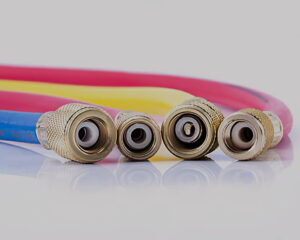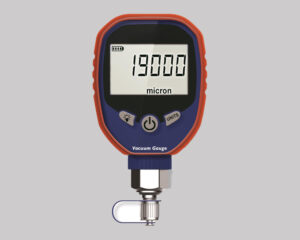The combination of Roots vacuum pump and single-stage rotary vane pump in a vacuum system brings significant advancements in vacuum performance. It boosts the vacuum level and pumping speed significantly.
Application of Roots vacuum pump system
The Roots vacuum pump system finds extensive use in various applications demanding rapid pumping in the medium vacuum range. It proves invaluable in a multitude of scenarios, including:
- Vacuum smelting processes
- Vacuum packaging operations
- Leak detection systems
- Vacuum dehydration and drying tasks in industries such as air conditioning and refrigeration
- Pre-stage pumping for molecular pumps or diffusion pumps in coating systems, and many more.
Primary vacuum pumps
To achieve better pumping speed and ultimate pressure, it is essential to use Roots (booster) pumps together with primary pumps. The primary pumps include single-stage rotary vane vacuum pumps, liquid ring vacuum pumps, and claw pumps.
The selection of the primary pump depends on several factors for different applications, including:
- Desired pumping speed and ultimate pressure requirements. The vacuum level of the vacuum pump shall be higher than that of the vacuum equipment by half to one order of magnitude. For example, for a vacuum requirement of 100 Pa, the vacuum pump shall be able to achieve 50 Pa to 10 Pa.
- Properties of the gas being pumped (condensable, flammable, corrosive, etc.).
- Cleanliness standards and requirements for the vacuum system.
The ratio of pumping speed between Roots vacuum pumps and primary vacuum pumps is largely determined by two factors:
- Efficiency of the vacuum system.
- Pressure differential limitations at the inlet and outlet of the Roots pump.
Equations for Roots vacuum pumps
Roots pumps operate at high rotational speed and exhibit high volumetric efficiency. As a result, for vacuum pumps with the same flow rate, Roots vacuum pumps have smaller dimensions and lighter weight. The flow rate typically ranges from 250 to 13,000 m3/h.
An important advantage of Roots pumps is that they do not require lubricating oil in the pumping chamber. Therefore, they are highly suitable for vacuum drying, distillation in the chemical industry, and pumping of special gases in the semiconductor/electronics industry.
Below are some commonly used calculation formulas for Roots pumps:
1. Theoretical pumping speed (STH):
STH = 4 × n × V
where:
n: The rotational speed of the rotor.
V: The volume of the chamber when isolated from the inlet.
2. Theoretical flow rate:
Q PV,th = STH × Pin
Roots pumps have clearances that cause internal leakage. This leakage reduces the pumped gas volume. Therefore, the effective gas flow rate can be calculated as:
q PV,eff = q PV,th – q PV,int,leak
The internal leakage rate, q PV,int,leak, is determined by the clearance gap and the pressure difference between the outlet (Pout) and the inlet (Pin), along with the leakage flow conductance (Cgap) of the internal clearances. It can be expressed as:
q PV,int,leak = Cgap × (Pout – Pin) + Sb × Pout
Here, Sb represents the effective conductance of the bypass channels or leakage paths. These equations provide a means to estimate the actual gas flow rate taking into account the internal leakage of the Roots pump.
3. Zero flow compression ratio (K0):
An important technical parameter of the Roots pump is K0, also known as the zero flow compression ratio. The peak compression ratio of the Roots pump is determined under zero flow conditions. It represents the ratio of the exhaust pressure to the inlet pressure.
K0 = (pout/pin)
where Pout is the pump’s exhaust pressure and Pin is the pump’s inlet pressure.
K0 is influenced by the shape of the rotor and the internal clearances of the pump. It also depends on the type of gas being pumped.
When the inlet of the closed Roots pump is sealed, it is possible to introduce a certain adjustable amount of gas into the inlet of the Roots pump and the preceding stage pump. This allows for different K0 values corresponding to different exhaust pressure conditions. By adjusting the inlet gas, the K0 value can be varied accordingly.
4. Efficiency (η):
The leakage of a Roots pump varies at different exhaust pressures, resulting in different zero flow compression ratios. The efficiency of a Roots vacuum pump can be calculated using the equation
η = K0/(K0+Sratio-1)
where S ratio represents the pumping speed ratio between the Roots pump and the preceding stage pump.
From this equation, it can be deduced that when Sratio = 1, the efficiency of the Roots pump is equal to 1. As S ratio increases, the efficiency decreases. When K0 is greater than 20 and the pumping speed ratio is less than 10, the efficiency of the Roots pump can exceed 70%. Generally speaking, this efficiency is considered acceptable as the lower limit.
5. Ultimate pressure (Pul):
Pul=K0 x Pout x (3-5)
The ultimate pressure of a Roots vacuum system is generally obtained by dividing the pressure drop of the preceding stage pump by the compression ratio. In practice, the obtained ultimate pressure needs to be multiplied by a correction factor of 3 to 5.
For example, if a single-stage rotary vane pump is used as primary pump, the theoretical lowest achievable ultimate pressure of the vacuum system would be 50 Pa / 35 = 1.4Pa. However, the typical achievable ultimate pressure is around 5 Pa.
If a water-sealed liquid ring pump is used as primary pump, the theoretical lowest achievable ultimate pressure of the vacuum system would be 3300Pa / 15 = 220 Pa. In practice, the typical achievable ultimate pressure is around 660 Pa.
To prevent excessive pressure difference and potential overheating and overload of the Roots pump, Roots pumps without overflow valve installations must be started after the primary pump reaches a certain pressure. This pressure can be calculated using the following formula:
P switch on = Maximum pressure difference / (Efficiency × Pumping speed ratio – 1)
6. Exhaust temperature of the Roots pump (Tout):
Tout = Tin × (Pout / Pin)^(1/6)
These formulas provide estimations for the ultimate pressure and exhaust temperature of the Roots vacuum system based on different parameters and considerations.
By raising the ratio of Pout to Pin to the power of 1/6, the formula provides an estimation of the relationship between the exhaust pressure and temperature. It assumes an isentropic compression process in the pump.
Summary
- In general, Roots pumps exhibit a zero flow compression ratio of over 20 within the exhaust pressure range of 10 to 2000 Pa. Consequently, to enhance vacuum levels, it is highly effective to opt for an oil-sealed 1-stage rotary vane pump or a liquid ring vacuum system with an ultimate pressure falling within the 10 to 2000 Pa range. This can elevate the vacuum level by at least one order of magnitude, if not more.
- Primary pumps with higher vacuum levels, such as 2-stage rotary vane pumps, can accommodate larger pumping speed ratios, typically reaching around 10. On the other hand, primary pumps with lower vacuum levels, like water-sealed liquid ring pumps, usually demand lower pumping speed ratios. In certain cases, a pumping speed ratio of 1 for the Roots pump is preferred to enhance vacuum levels and mitigate issues such as cavitation.
- 3-stage (or more) Roots pumps can achieve an ultimate pressure as low as 0.01 Pa.
- To prevent overload or overheating of the Roots pump, it is advisable to allow the primary stage pump to operate and reach the desired pressure before starting the Roots pump. Another approach is to equip the Roots pump with overload protection mechanisms like relief valves or magnetic couplings. In cases where these protection devices are present, it is also recommended to introduce a slight delay before starting the Roots pump. This helps to minimize noise and mitigate other potential factors, ensuring smooth and safe operation of the Roots vacuum pump system.
Coolink, a TOP 3 Global HVAC Vacuum Pump Manufacturer & Quality Industrial Vacuum Pump Supplier from China






